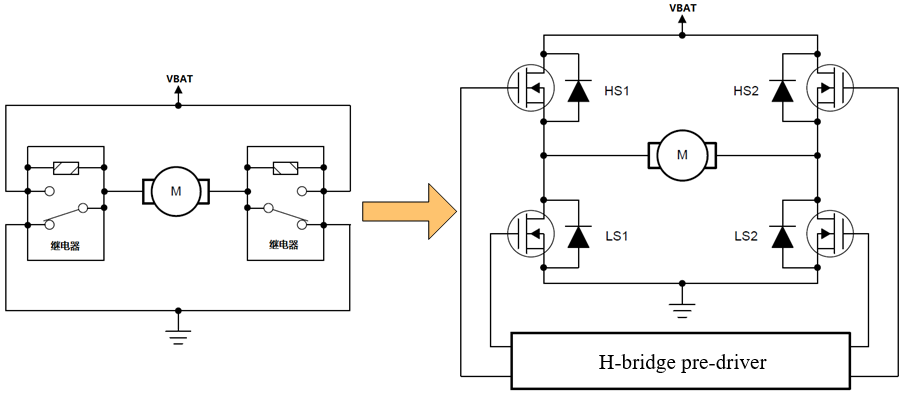Application of DC brushed motors in automobiles
2025-07-09 11:21:23 387
Introduction to Brush-Type DC Motors Brush-type DC motors, commonly referred to as brush motors, are a type of DC motor widely used in household appliances. Their key components include fixed main poles and brushes on the stator, as well as armature windings and commutators on the rotor. Electric power from the DC power source enters the armature windings through the brushes and commutator, generating armature current. The magnetic field produced by the armature current interacts with the main magnetic field to generate electromagnetic torque, causing the motor to rotate and drive the load. Due to the presence of brushes and commutators, brushed motors have a complex structure, poor reliability, frequent failures, high maintenance requirements, short lifespan, and commutation sparks that can cause electromagnetic interference. In daily life and numerous electronic products, brushed miniature DC motors play a critical role. These motors are widely used in household appliances, providing power for various products such as coffee makers, razors, facial cleansers, and beauty devices.
Brushed miniature DC motors have gained widespread application due to their simple control methods and low cost. These motors can operate by simply applying DC power, and their speed can be easily controlled by adjusting the voltage. In contrast, brushless miniature DC motors require additional circuitry support and have lower torque at low speeds. Products with torque requirements may need to add a gearbox. Additionally, brushless miniature DC motors have relatively higher requirements for product design structure and cost. Therefore, in most cases, brush-type miniature DC motors are the preferred choice for electronic products. Brushless DC motors are only considered when product parameters have extremely high requirements that cannot be achieved with brush-type motors.
The requirements for automotive electronics design are becoming increasingly stringent, with functional safety and fault detection mechanisms being indispensable components. An increasing number of motors are being applied to automobiles, and selecting a brushed DC motor drive that meets automotive grade requirements can simplify design and enhance safety performance. The application of motors in automobiles enables automation, enhances driving safety, and improves comfort. Different types of motors are applied to various functional modules in automobiles based on their respective characteristics. Brushed DC motors are also used in multiple functional modules of automobiles, as shown in the figure below. Automatic window regulators are now standard in almost every vehicle, eliminating the need for traditional manual crank systems; electric seat adjustment has replaced traditional manual mechanical systems; and electric trunk and sunroof systems, which are common in luxury vehicles, are all achieved using brushed DC motors. This article introduces the HCV7535, a function-enhanced H-bridge pre-drive chip that meets automotive grade requirements. When driving a brushed DC motor, either high-side or low-side drive can be used, with the control power connected to the motor's ground input terminal, making it simple and practical. When controlling the motor to achieve forward and reverse rotation, an H-bridge can be constructed to achieve this, as shown in the H-bridge drive diagram below.

Figure. 1
A simple H-bridge circuit can be implemented using two relays, with the external circuit driving the relays to the closed state. While this relay-based H-bridge drive is simple and practical, it has significant limitations, such as larger size, slower switching speed, and inadequate performance in speed control. In the current trend toward higher power density requirements, there is a need for components with faster switching speeds and smaller sizes to replace relays. MOSFETs have fast switching speeds, low on-resistance, strong overcurrent capability, and are non-contact electronic switches, making them ideal for replacing relays in driving brushed DC motors. They also facilitate reducing the circuit footprint. Since MOSFETs have significantly higher switching speeds than relays, speed control can be achieved through PWM.
In modern automotive electronic systems, brushed DC motors are widely used in electric seat adjustment mechanisms, achieving multi-level position memory functions through PWM speed control technology. In vehicle air conditioning systems, the motor-driven damper actuator can precisely control airflow direction and volume. Electric power steering systems utilize high-torque brushed DC motors to provide precise steering torque control. Brushed DC motors serve as the drive core in household drum-type washing machines, with their smooth startup characteristics effectively reducing vibration and noise. In vacuum cleaners, high-speed brushed DC motors can generate suction power exceeding 20 kPa. Variable-frequency refrigerator compressors use specially designed brushed DC motors to achieve energy efficiency ratings of A++.
In the flap control system of commercial aircraft, redundant-designed brushed DC motor assemblies ensure absolute reliability in flight attitude adjustments. Drone gimbal stabilization mechanisms use miniature brushed DC motors to achieve anti-shake compensation for captured footage. The deployment mechanism of spacecraft solar panels relies on space-grade brushed DC motors to achieve precise angular positioning. Impact drills use high-power-density brushed DC motors, maintaining stable rotational speed even at a rated power of 600W. Angle grinders are equipped with industrial-grade brushed DC motors, capable of continuous operation for 4 hours without overheating protection. Garden chainsaws use waterproof brushed DC motors, maintaining a cutting speed of 3000 rpm in humid environments. As demonstrated by these application examples, brushed DC motors, with their mature technology and excellent cost-effectiveness, continue to play a critical role in numerous industrial fields, showcasing their robust technological vitality.




